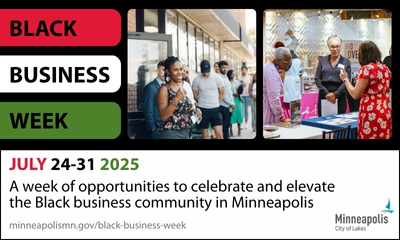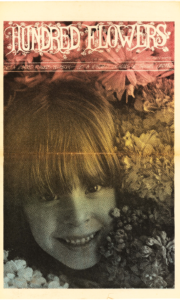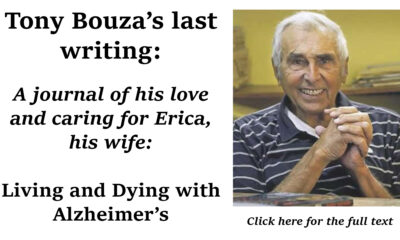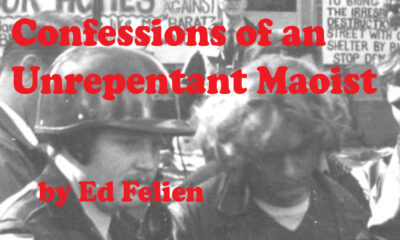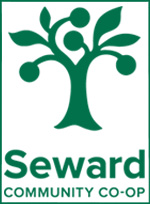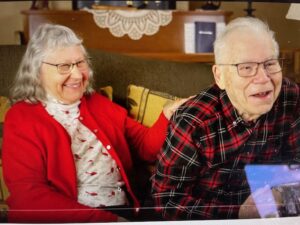
Inside Senior Living episode one, featuring Jean and Gary
BY STEPHANIE FOX
Melissa Fritz had worked for nearly a dozen years assisting families circumnavigating the transitions of aging, when she found herself helping her own family through the process. Her father had begun suffering with the symptoms of Alzheimer’s, and when the pandemic began, the isolation made her usually outgoing father’s symptoms worse. That left her mother struggling with the changes in her father’s personality. But it gave Melissa a close up and personal view of the things she’d been seeing with families she’d been helping. It was a revelation.
“What I realized,” she said, “is that families don’t want to talk about aging and end of life changes. People struggle to remain independent. People want to age in place, but instead of having conversations before a crisis happens, and because of the cost, people wait until they are in their 80s and sometimes 90s before they make a move.”
Fritz could see that getting people to talk about these uncomfortable topics early could help families start to make the important decisions they might, at some point, be forced to make.
“Although there are so many good resources available to help, families need to know where to start,” she said.
She began to research what she could do to make this happen.
She looked into creating a series of documentary shows, something like the television show “House Hunters”, but for senior living. After taking online documentary classes, she felt ready to hire local video producers to make a sizzle reel, and she began to pitch the idea to major TV networks. She contacted Lifetime, Discovery, A&E, HGTV, Warner Brothers and others, but got little response until she heard from PBS North and Twin Cities Public Television. “They believed in this project and agreed to coproduce and distribute it nationally,” she said.
Last November, the first show was broadcast, with a total of eight episodes featuring a cast of older adults talking about the transition difficulties they and their families were experiencing.
“The cast of eight different older adults also showcased diversity in the Minnesota aging populations,” she said. The show featured not just white people but included others such as LBGTQ, Indigenous, African Americans, and Latino, as well as the contrast of rural and urban communities. “And the series includes more than 20 aging-industry experts who give insights and advice to viewers.”
The show was shot using all Minnesota cast and crew, showcasing the positive economic benefits of film/TV production in Minnesota as well, she said. A number of local organizations supported the show, including the Alzheimer’s Association MN-ND, MN Veteran’s Affairs, Sabathani Community Center, and Care Providers of MN.
At the end of the first season, Fritz estimates that on the 340 PBS affiliates, the show may have had multi-millions of viewers. The show is still available for viewing on the Inside Senior Living YouTube channel, filmnorth.org/fiscally-sponsored-projects/inside-senior-living/.
“The number one reason that people end up in the hospital and then into transitional care are falls. These people are no longer safe living in their own homes.” This means that family become decision makers and caregivers.
Fritz is hoping that there could be a second season of the show, this time also offering support to those who care for their elderly relatives and friends. “I’d like this to focus on caregivers and help connect them with resources,” she said. “There is a wealth of resources that the public doesn’t know about.”
“While the elderly are in crisis, the demographic mostly dealing with them are adult daughters aged 35 through 55. These caregivers can become isolated and experience burnout,” she said. “They also need support.”
Fritz said that her main motivation for continuing the show is to be able to help people. “My goal is not to move anyone to a senior living facility. But what we can do is to help normalizing conversations about the end of life. I was lucky in having the right idea at the right time. I want to bring this conversation on aging into mainstream culture.”
Fritz said that to help advance these discussions, attitudes need to change. “Native culture celebrates their elders,” she said. “A lot of terms for old people are negative and that needs to change. We have to start viewing aging in a more positive light.”
There are so many great resources out there, but families don’t know what or where to look for them, she said. She hopes to encourage people who need advice about where to go to learn their choices, to visit to her website, InsideSeniorLiving.TV if they have questions.
“Families wait until they are in crisis and their options are reduced. Aging is a good thing but when they effect independence, that can be a problem,” she said. “Why aren’t we talking more about this? We have to stop avoiding the inevitable. We need to talk about our wishes and then plan for it.”
Link to watch the show: pbsnorth.org/show/inside-senior-living/
You can also watch here: youtube.com/watch?v=ZbuUXWN0iWg&list=PLXWIK0UUf6dA00wfuJZnqdxHKKe6wg4F3
Learn more: insideseniorliving.tv
Here’s a link to the FilmNorth Fiscal Sponsorship page: filmnorth.org/fiscally-sponsored-projects/inside-senior-living/




